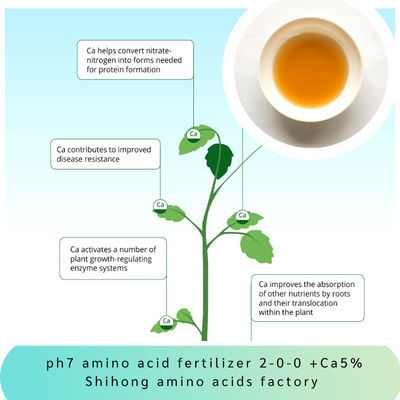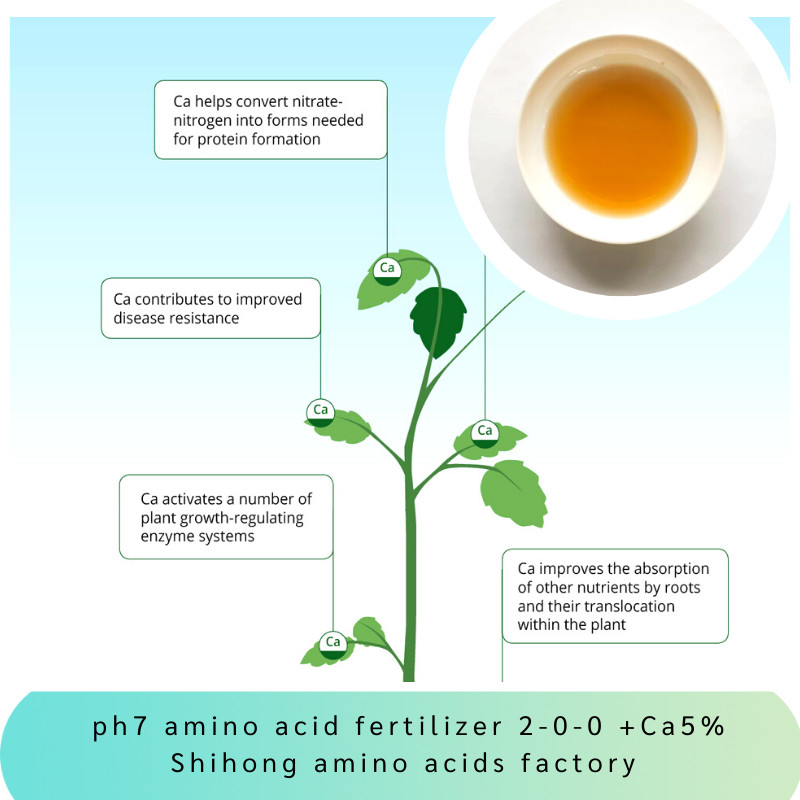Enzymatic Amino Acid Chelated Calcium 5% +NPK 2-0-0 Organic Nitrogen Liquid Fertilizer Chlorine Free
Enzymatic Amino Acid Chelated Calcium Products description:
Extracted from natural organic soybean protein , with healthly enzymatic production process , this product is charaterized by chlorine free ,free of inorganic nitrogen and nitrates& ammonium compound. It is 5% calcium ,1% organic nitrogen ,which is organic nitrogen of amino acid itself , amino acids organic fertilizer as a functional nurtition organice fertilizer .
The benefits of amino acids organic fertilizer are supply essential amino acids , stimulate and regulate plant rapid and healthily growth, promote crops nutrition absorption and metabolic function , as well as promote the development of plant roots and accelerate the growth and reproduction of plants.
Calcium (Ca) plays an extremely important role in producing plant tissues and it enables plants to grow better. Calcium is responsible for holding together the cell walls of plants. It is also crucial in activating certain enzymes and to send signals that coordinate certain cellular activities.
Enzymatic Amino Acid Chelated Calcium Specification:
| Appearance |
Yellow Clear Liquid |
| Density |
1.17 |
| Organic Calcium |
5% min |
| Organic nitrogen |
2% min |
| Carbohydrates |
5~7% |
| PH |
5~7 |
| As |
≤ 0.0005% |
| Pb |
≤ 0.001% |
| Hg |
≤ 0.002% |
Enzymatic Amino Acid Chelated Calcium Application:
General application rates:
Foliar (with 15 to 21 days interval): 200-400 cc/100 liters of water.
Root: 10-15 l/ha and crop cycle distributed in several applications with 15 to 21 days interval.
CROP DOSAGE FOLIAR APPLICATION NUMBER OF APPLICATIONS/FREQUENCY
Fruit vegetables 2 - 2.5 l/ha 2 - 5 applications, active growth and along with phytosanitary products
Leaf vegetables 2 - 2.5 l/ha 2 - 4 applications, active growth and along with phytosanitary products
Citrus and subtropical crops 2 - 4 l/ha Pre blooming, petal fall and during fruit formation
Fruit trees, olive trees and vines 2 - 4 l/ha Sprouting, pre blooming, fruit formation and veraison
Extensive and ornamental 1.5 - 3 l/ha 2-4 applications, along with post-emergency weedkillers, at beginning and end of tillering
Fertigation Apply 10-15l/hectare
Warm reminding :
Mix it with pesticides, which will enhance the function with each other
Please spray it before 10 am or after 4 pm so that the plant will have the best absorption.
Please re-spray it if the rain comes in 2hours.
Improve crop stress resistance
Threonine is an acid-base amphoteric substance, in which the carboxyl group is acidic and the amino group is alkaline. Threonine can adjust the cell pH after entering the cell. At the same time, threonine can be converted into pyruvic acid, malic acid, citric acid and other substances to maintain the cell pH stability and improve the tolerance of crops to changes in acid and alkali. Threonine can be phosphorylated on the cell membrane, participating in the plant pathogen interaction response, and playing an important role in the disease resistance response. The black spot fungus produces a degrading enzyme that penetrates the cell wall and infects crop cells. After receiving the infection signal, threonine on the cell membrane is specifically phosphorylated, causing deionization of the plasma membrane of the infected part of the plant, exchange with ions inside and outside the cell, and generate transmembrane particle flow, Stimulate the downstream disease resistance reaction, so as to have limited resistance to black spot disease. Threonine can also be converted into other amino acids to participate in crop morphogenesis. The metabolic pathway of threonine in the crop is different from that of other amino acids. It is the only amino acid that is converted into other substances through the catalysis of threonine dehydratase (TDH), threonine dease (TDG) and threonine aldolase (THA) without the action of dehydrogenase and transamination, Through these three metabolic pathways, threonine can be converted into key substances of amino acid metabolism cycle after being absorbed by plants, and then converted into various other kinds of amino acids to participate in crop morphogenesis.



 Your message must be between 20-3,000 characters!
Your message must be between 20-3,000 characters! Please check your E-mail!
Please check your E-mail!  Your message must be between 20-3,000 characters!
Your message must be between 20-3,000 characters! Please check your E-mail!
Please check your E-mail! 










